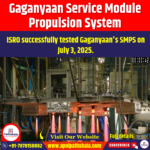Why in News?
ISRO launched the SpaDeX (Space Docking Experiment) mission on December 30, 2024. This mission will deploy two spacecraft into a 470 km orbit using PSLV-C60. On January 7, 2025, these spacecraft will dock at high speed.
Introduction of Docking and Undocking in Space Technology
Space docking and undocking are critical processes in modern space exploration. This process enables spacecraft to connect or separate in orbit. These procedures are not only crucial for assembling complex structures in space but also for maintaining operational functionality, such as crew exchanges, resupply missions, and satellite servicing.
- Docking is an essential operation, especially for constructing and maintaining space stations. A prime example of this is the International Space Station (ISS), where multiple modules were launched separately and then docked in orbit to form the station. This ability to dock allows for the transfer of goods, crew members, and scientific equipment, making long-term missions in space possible.
- On the other hand, undocking plays an equally vital role, especially when spacecraft need to return to Earth or move to a different orbital position. The process requires precision and advanced navigation to ensure the safe separation of two objects traveling at high velocities in space.
- While docking and undocking are the most common methods used for spacecraft to join or separate, berthing is another crucial maneuver. Berthing occurs when a spacecraft or an unpowered module requires external assistance to reach a docking port. For example, the Space Shuttle used its robotic arm to berth modules to the ISS, lifting modules into place when they couldn’t dock independently.
The concept of docking in space began in the 1960s. The first successful docking in space occurred in 1966, when the Gemini VIII mission successfully docked with the unmanned Agena target vehicle.
Why Space Docking and Undocking Matter
Space docking and undocking are more than just technical feats; they are essential for a wide array of space exploration and satellite missions. These operations facilitate many significant goals:
- Scientific Understanding: Through space exploration, we deepen our knowledge of the universe, including complex phenomena like dark matter, dark energy, and the nature of black holes. Docking technology allows for research instruments to be safely placed in orbit for continuous study.
- Technological Advancements: Space exploration has spurred technological innovations that have made life on Earth more convenient. Satellite telecommunications, global positioning systems (GPS), and weather forecasting are just a few examples of technology developed through space missions.
- Earth Science Research: Satellites play a crucial role in monitoring climate change and understanding natural and human-induced environmental shifts.
- Economic Development: Space exploration contributes to economic growth through the development of space industries. This sector yields high returns on investment, driving job creation, technological innovation, and even the commercial space market.
- Communication: Satellites are fundamental to modern communications, providing essential services in remote regions, to ships at sea, and for global broadcasting. Without effective docking technology, maintaining and upgrading these satellites in orbit would be much more difficult.
Types of Space Docking Systems
Space docking systems play a pivotal role in the assembly, maintenance, and operation of space stations, as well as in the transfer of cargo and crew between spacecraft. Each docking system has been developed to meet specific mission requirements. Below are some important docking systems:
- The Active Common Berthing Mechanism (ACBM) is designed for both docking and berthing operations. The ACBM includes an active mechanism that helps guide a spacecraft to its docking port and holds it in place once it is secured.
- The Androgynous Peripheral Attachment System (APAS) was developed as a universal docking mechanism for spacecraft. The term “androgynous” refers to the system’s ability to allow either spacecraft to be active or passive, which makes it more flexible for different mission types.
- The Soft Capture Mechanism (SCM) is designed to allow for a gentle docking process. This system is used to align two spacecraft and make their initial contact using a passive attachment, then the docking.
- The International Docking System Standard (IDSS) represents a global effort to create a unified docking system for spacecraft. This is developed to be compatible with different space agencies’ hardware.
- The Apollo Docking Mechanism was one of the early innovations in space docking, used during the Apollo missions. This system used a probe and drogue configuration, where one spacecraft (the Apollo Command/Service Module (CSM)) would extend a probe.
In most docking operations, one spacecraft assumes the active role, where it actively maneuvers to dock with the other spacecraft. The second spacecraft takes on the passive role, where it remains stationary or only makes minor adjustments.
The Docking Process: How Does it Work?
The docking process is essential for space exploration as it facilitates the transfer of crew, cargo, and fuel between different vehicles in space. Here’s a step-by-step information of how the docking process works:
- Approach: The two spacecraft begin by carefully approaching each other. This phase involves precise navigation to ensure that both vehicles align properly, as even the slightest misalignment can prevent successful docking. During this phase, the spacecraft are usually traveling at high speeds, and the approach must be slow and controlled to prevent collision.
- Soft Dock: Once the spacecraft are in close proximity, they make contact and the docking connectors begin to latch together. This phase is called soft docking. At this point, the docking mechanisms make an initial connection, but the spacecraft are still slightly separated.
- Hard Dock: The final phase is hard docking, where the spacecraft securely connect to each other. In this phase, if the spacecraft are designed to be pressurized, the docking mechanisms form an airtight seal between the vehicles. This seal allows the hatches of both spacecraft to open, enabling the transfer of crew, supplies, and other materials between them.
The entire docking process requires extreme precision and coordination, as even minor errors can lead to mission failure.
The Indian Docking System (BDS)
The Indian Docking System (BDS) was developed by the Indian Space Research Organisation (ISRO) after initial unsuccessful attempts to import docking technology. It was designed to meet the needs of future Indian space missions like the Gaganyaan crewed mission and Indian Space Station (ISS).
- In 2016, initial studies were conducted by ISRO to explore docking technologies.
- The Indian Government approved an initial fund of ₹10 crores for the space docking experiment, which was further approved in 2017.
- By June 2019, ISRO began exploring proposals related to remote robotic arm operation, rendezvous, and docking technologies using its PSLV (Polar Satellite Launch Vehicle) PS4 orbital platform.
- By July 2022, the space docking experiment was granted a funding of ₹124.47 crores (equivalent to ₹132 crores or US$15 million).
- Two 220 kg satellites named “Chaser” and “Target” have been deployed into orbits at an altitude of 470 km with a 55-degree inclination. These satellites will perform precise maneuvers to meet and dock in space.
The success of recently launched SpaDeX is crucial for the planned Indian Space Station and Gaganyaan space missions. The autonomous docking system will also be an integral part of future missions, including Chandrayaan-4. This will reduce dependency on external guidance systems like GNSS.
Challenges in Space Docking and Undocking
Space docking and undocking face various technical challenges. These maneuvers require highly sophisticated technology and precise operations. Below are some key challenges:
- Precision: Space docking and undocking require extremely precise alignment and coordination between spacecraft, especially when dealing with smaller or more delicate vehicles. The spacecraft must approach each other with sub-millimeter accuracy to ensure successful docking.
- Low Mass and Inertia: Due to the low mass and inertia of spacecraft, even a small force or external disruption can cause a satellite to drift off its intended path. This means that the spacecraft must be controlled very carefully during the docking process, as small errors in velocity or trajectory could result in significant misalignments.
- Speed: Achieving successful docking in space involves traveling at incredibly high speeds, often around 28,800 km/h (the speed at which objects orbit Earth). The spacecraft must decelerate and align perfectly within these extreme velocities.
- Building a Compact Design: Spacecraft docking systems must be designed to be compact and low-impact, ensuring that they are compatible with modular spacecraft configurations.
- Payload Performance: Once spacecraft have undocked, the performance of the payload becomes a critical consideration. The undocking process can affect the stability and functionality of onboard instruments or systems.
- Energy Transfer: Validating the energy transfer between docked spacecraft is essential for ensuring smooth operations. Energy exchange, such as electrical power between spacecraft, must be reliable and efficient to support the mission’s duration.
Conclusion : The future of space docking technology will focus on enhancing autonomous docking systems, improving precision, and developing modular designs for flexible space station assembly and maintenance. Advanced robotics, AI-driven navigation, and low-impact docking systems will enable seamless interactions between spacecraft. With the rise of commercial space missions, docking technology will be critical for crew transfer, cargo delivery, and satellite servicing, ensuring the sustainability of long-duration space missions and paving the way for interplanetary exploration.
Explore our Books: https://apnipathshala.com/product-category/books/
Explore Our test Series: https://tests.apnipathshala.com/









